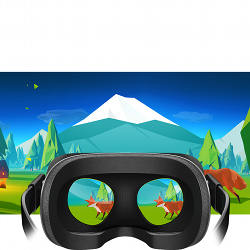
Three-dimensional (3D) head-mounted displays (HMDs) have one significant disadvantage: the mismatch between vergence (the simultaneous movement of both eyes in opposite directions, required for binocular vision) and accommodation (the focusing of the lens within the eye to sharpen the image on the retina).
Explains Robert Konrad, a researcher on the Computational Imaging Group at Stanford University, "Much like how a camera can adjust its lens to bring objects at different distances into focus, people’s eyes have various muscles that are used to enable us to see clearly across a range of depths. During our day-to-day lives, these muscles work together constantly (and below our level of consciousness) to ensure that our vision is clear and in focus."
To accomplish this, Konrad says, "One set of muscles ensures that both of our eyes point at the same object (so we don’t have double vision); this eye movement is called vergence. Another muscle inside each eye adjusts the focus of the eye’s lens so this object is also in focus; this process is called accommodation.
"The ‘vergence-accommodation conflict’ refers to the fact that current-generation stereoscopic (3D) displays can only correctly drive the vergence response as we explore a simulated environment, but not the accommodative response. Because the images are presented on screens at a fixed optic distance, accommodation to keep the images in focus has to stick to a fixed distance, whereas vergence to fixate different objects in depth varies. This conflict can result in your eyes having a tired or strained feeling, as well as a reduction in the clarity of vision."
To mitigate such 3D viewer fatigue, researchers at Dartmouth College and Stanford University have been experimenting with adjusting the focus settings on objects in a virtual reality (VR) scene depending on whether they are virtually closer to or further from the viewer. This removes the stress from the vergence-accommodation error, since the eyes no longer have to focus on objects as equidistant, but rather can "relax" for the objects that are out of focus, and properly tighten up for objects that are presented in focus. That is not exactly the way normal stereoscopic (3D) vision works, but it is close enough to eliminate fatigue in many cases, according to the researchers.
After experimenting with several variations, the researchers concluded that for most 3D viewers, the "monovision" technique used in ophthalmology for generations reduces fatigue in the easiest to implement fashion. Monovision places nearby objects in focus in one eye, while the other eye focuses on far-away objects; users learn to allow one eye or the other to determine their frame of reference, depending on what they are looking at in the 3D image.
While not a perfect solution, monovision has been used successfully by ophthalmologists for years, and could mitigate the vergence-accommodation conflict in 3D VR.
A team including Emily Cooper of Dartmouth College, Gordon Wetzstein and the above-mentioned Konrad at Stanford, presented a paper on Novel Optical Configurations for Virtual Reality: Evaluating User Preference and Performance with Focus-tunable and Monovision Near-eye Displays at the ACM Conference on Human Factors in Computing Systems (CHI 2016) in early May.
Says Laurie Wilcox, who studies stereoscopic vision in her lab at York University, "The work presented in this paper is innovative. As the authors note, monovision is typically used by optometrists to help individuals with advancing presbyopia [extreme farsightedness]. The use of this technique in head-mounted displays is promising, and from the results it appears that viewers both benefit from, and prefer using, VR displays with simulated monovision.
"Research of this type will be important as VR and near-eye display systems become widely available and heavily marketed to consumers."
The Dartmouth and Stanford researchers started with the Oculus Rift head-mounted display, then added focus-tunable liquid lenses that allowed them to put foregrounds, midgrounds, or backgrounds into focus, or blur them. They tested for vergence-accommodation fatigue using many different combinations of depth fields, and determined the best solution was the monovision paradigm, which puts close-range objects in focus for one eye and far-range objects in focus for the other eye, without having to resort to expensive adaptive circuitry. After a training period with the monovision solution, test subjects reported significantly reduced levels of vergence-accommodation fatigue.
Said Konrad, "Long-term comfort tests for users with normal vision that experience monovision in a VR environment only will have to be tested. If the users are not able to adapt, monovision might be uncomfortable, or if they adapt too well, they may experience after-effects" when taking off the HMD.
The team now is experimenting with automatically tunable focal distances, which can track the user’s gaze and adjust focus to match the point at which the user is fixating. Preliminary experiments show users may prefer this technique, although experiments so far have not utilized gaze tracking, but instead chose a specific target in the virtual reality scene as the point of focus and had the optics automatically track the perceived distance of that object.
Concluded Konrad, "Our study combined experiments that use a new technology (focus-tunable optics) and an old technology (monovision). Both the focus-tunable modes and the monovision mode demonstrate improvements over the conventional display. Focus-tunable optics may not be ready for integration in current-generation VR systems, but hopefully integration is not too far off.
"Monovision is a simple low-tech solution—although more research is necessary and planned for the future."
R. Colin Johnson is a Kyoto Prize Fellow who has worked as a technology journalist for two decades.



Join the Discussion (0)
Become a Member or Sign In to Post a Comment